Table for Two is a series focusing on two-player games. Today’s game is Strife: Shadows & Steam, a stand-alone sequel to Strife: Legacy of the Eternals (originally reviewed here). The original game was set in a fantasy world; this time it’s steampunk.
At a glance: Strife is a game by Christopher Hamm for 2 players, ages 14 and up, and takes about an hour to play (though there are variants for shorter or longer games). It’s currently seeking funding on Kickstarter and the pledge for a copy is $15; the expected retail price is $20. It is okay for younger players content-wise, but figuring out the strategy can get complex.
New to Kickstarter? Check out our crowdfunding primer.

Components:
- 20 Champions cards (2 sets of 10 each)
- 10 Locations cards
- 4 Score cards
- 1 Fatestone (8-sided die)
- Various tokens
The number and type of tokens may change, but my prototype version came with:
- 6 +1 Power tokens
- 3 -3 Power tokens
- 4 -1 VP tokens
Also, there are stretch goals in place to add 9 Event cards and 9 Artifact cards to the deck (similar to the first game). Because of the success of the previous campaign, this one starts off with the upgraded card stock and a metal tin box that were stretch goals the first time around.
As with the first game, the cards are all Tarot-sized cards, with a large portion of the card taken up by the artwork by Claudio Pilia. While I do really like the artwork in the game, I do feel that the text on the cards is smaller than it needs to be on such a large card. In my opinion, it would be worth it to shrink the art if it meant not having to squint at the text.
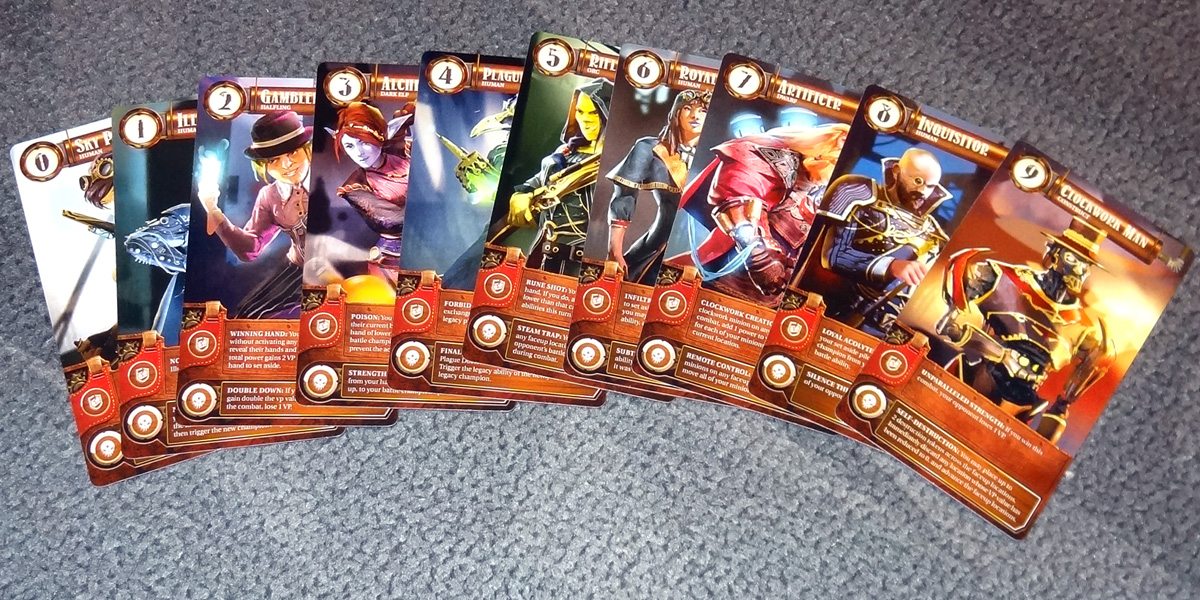
Each of the Champion cards has a name, a number (from 0 to 9) and two abilities: the Battle ability and the Legacy ability. The Location cards each have a name and an effect, usually awarding a bonus to a particular class of champion.
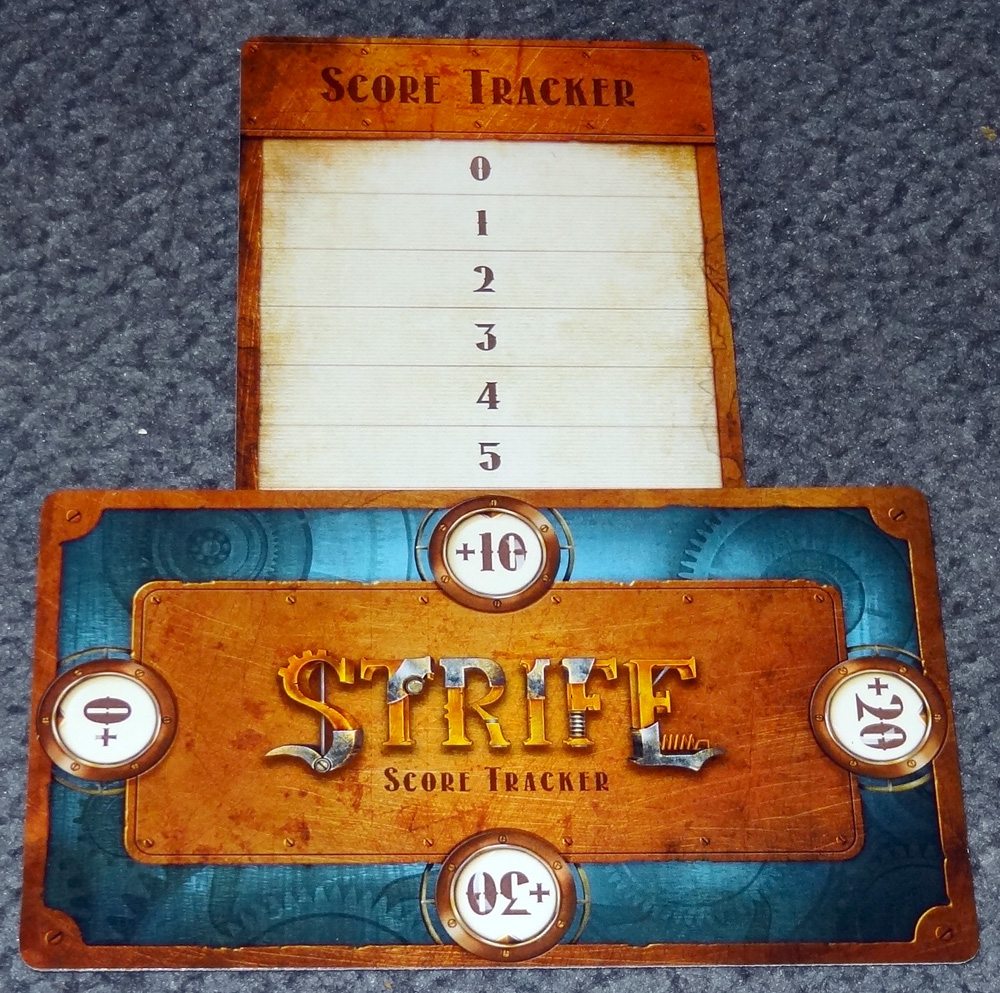
The score cards are a pair of cards: one has 0 to 9 printed vertically on the card, and the other has +0, +10, +20, and so on printed on the edges (on front and back, so it goes up to +70). You just slide one card over the other to keep your score from 0 to 79. The original game was the first time I’d seen a score tracker like this, and since then I’ve seen it in a few other games, but not many. It’s such a simple but clever solution–just be sure you don’t bump the cards too much while you’re playing.
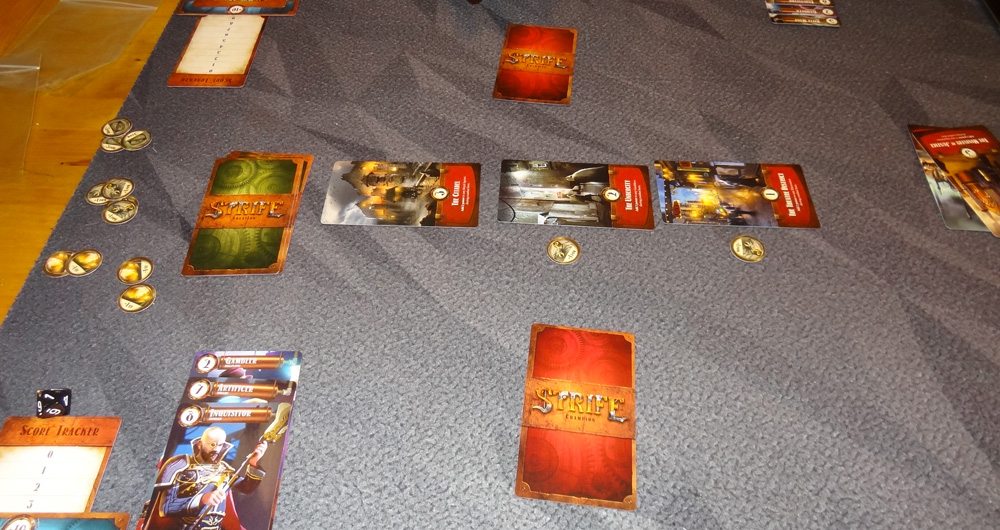
How to Play
You can get a PDF of the rules here, or even try the full Print-and-Play edition before you decide whether to back the game.
Note: since the rules for this version and the original are largely the same aside from the specific powers, much of this section will repeat my original review. Skip to the bottom if you just want to learn about the new tokens and combining the two sets.
The object of the game is to score the most points in three rounds of play. (The length of the game can easily be adjusted by agreeing on more or fewer rounds.)

The basic idea is that each Champion has two powers: a Battle ability that triggers when it is used in battle, and then a Legacy ability that affects the next battle. You gain points by winning battles to take Location cards.
Each player gets a set of ten Champion cards and two score tracker cards. The ten Locations are shuffled, and three are set out on the table with the deck to the side.
Assign the Fatestone: each player will choose a Champion to be their first Legacy Champion–these are revealed simultaneously and set aside in the Legacy pile. Whichever player has the highest power level takes the Fatestone, which starts at 1. (In case of a tie, roll off for the Fatestone.)

In each round, you choose a Champion to play on the current Location. Players reveal their Champions simultaneously. Then, you activate the current Champions’ Battle abilities, and then the previous Champions’ Legacy abilities, and then resolve combat by adding terrain bonuses. Whoever wins combat by having the larger combat value gains victory points according to the Location card (and any ability bonuses). Then, the current Champion is moved into the Legacy pile, the Location is discarded and a new one enters the row, and the next battle begins.
At the end of the round, when each player is down to one Champion in hand, that one becomes the Legacy champion for the next round, and all the previously played Champions return to the hand. Locations are reshuffled.
The Fatestone is used to break ties. Any time there is a tie, for any reason, the person holding the Fatestone loses the tie. Or, if desired, that player may increase the Fatestone value by 1 and pass it to the other player to win the tie (only one pass per tie). At the end of the game, though, the Fatestone is worth victory points equal to its current value.
The regular game ends after three rounds–highest score wins. In case of a tie, the player with the Fatestone loses.

So what’s new in Shadows & Steam?
Well, all of the champions have different abilities than the last set, but there are some in particular that use the tokens, which are totally new.
The Rifle Mage (strength 5) has a “Steam Trap” legacy ability: you may place a trap token onto any face-up location, reducing your opponent’s power by 3 at that location. It’s a good defensive move, allowing you to make a high-value location harder to win.
The Artificer (strength 7) has a battle ability that allows you to place a clockwork minion on any face-up location, increasing your power by 1 there. His legacy ability, “Remote Control,” lets you place 2 more clockwork minions on any location, and then move all minions 1 space in any direction. The combination of abilities lets you shift your extra power around to where you think you’ll need it most.
Finally, the Clockwork Man (strength 9) has a “Self-Destruction” legacy ability: place up to 2 destruction tokens on the face-up locations, reducing their point value. Any location with its value reduced to 0 is discarded.
The new set is also cross-compatible with Legacy of the Eternals, if you own both (or back the project at a level that gets you both games). Each player takes a full set of champions from one of the games, and then chooses 5 locations from that game (with a total VP value of 11). These locations are shuffled together to form the location deck, and then the game is played as usual.
There currently aren’t official rules for mixing and matching teams of champions from the two sets, though I’m sure there are folks ready to give that a try, too. The card backs are different, though, so your opponent would be able to tell which set you were using when you picked a card.
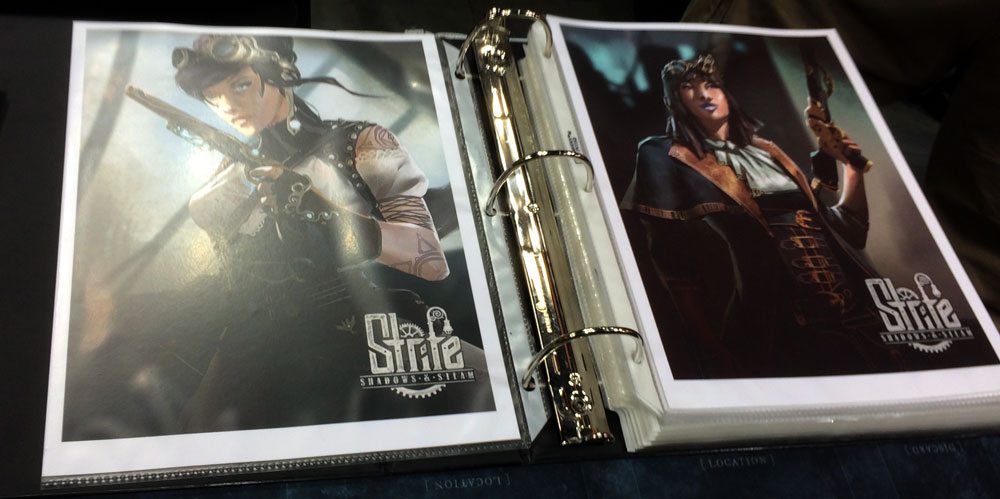
The Verdict
What can I say? I really loved the original Strife and I’ve been waiting for this sequel since I saw the sample artwork for Shadows & Steam at Gen Con last year. My opinion hasn’t changed much since my first review–Strife is a great 2-player game with a whole lot of strategic depth in a tiny package. You always know exactly what your opponent has left in their hand, and so it really is a battle of the wits; the only luck, really, is in the order of the Location cards, but even there you know the next two upcoming locations (and there are champions who can manipulate the locations, too).
My complaint about the size of the text on the cards still stands, but I can see that they wouldn’t want to overhaul the graphic design and layout for this set so they could be consistent. Just know that if you have trouble reading fine print, bring your reading glasses when you play this one. That’s my only real gripe about the components, though.
The one other caveat I’d mention is that if you play with people who have analysis paralysis, this can take a LONG time. I’d recommend trying with fewer rounds first, and also using just the battle abilities and no legacy abilities. However, keep in mind that leaving out the legacy abilities is cutting out more than half of the gameplay, because a huge part of the strategy is knowing how to string together combinations of champions to make the best use of their combined abilities. However, if you’re looking for a game that rewards repeated plays, Strife fits the bill. Victory depends on being able to anticipate what your opponent will do, and since you both have the same set of cards, it’s all in how you use them.
If you’re looking for a fantastic, inexpensive 2-player game, I highly recommend Strife: Shadows & Steam. Both sets have some really fun abilities, so you can just choose whether you prefer fantasy or steampunk–or just pick up both!
For more information, check out the Kickstarter page.
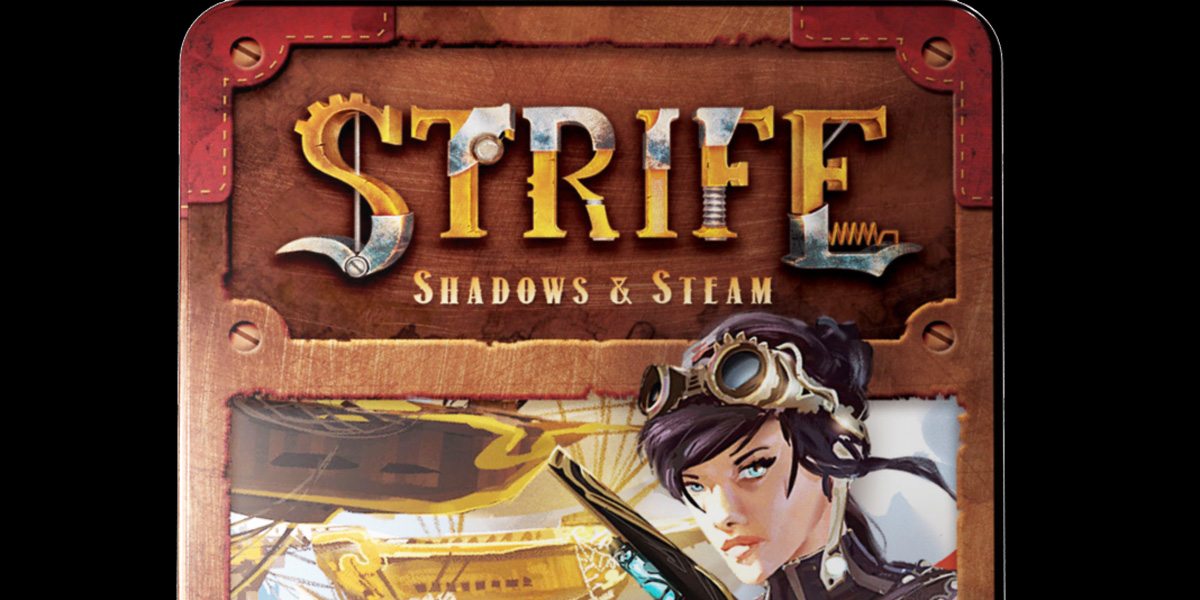
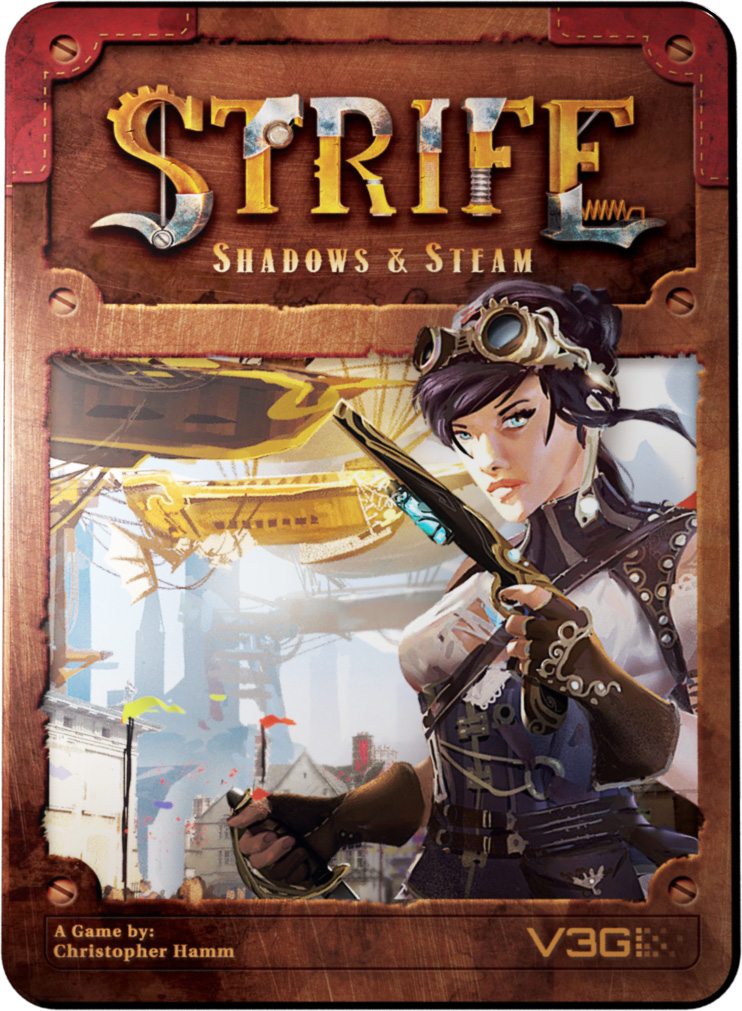




Jonathan, is the PnP version free to be distributed even now that the Kickstarter campaign ended?